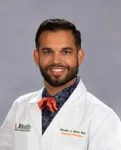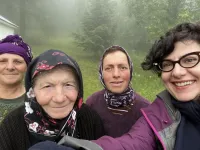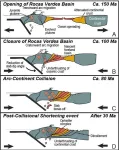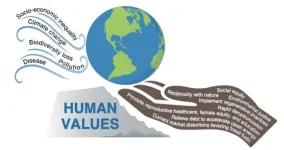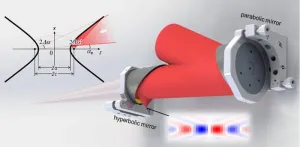(Press-News.org) MIAMI, FLORIDA (EMBARGOED UNTIL APRIL 4, 2024, at 6:30 pm EDT) – Annual prostate cancer cases worldwide are projected to double by the year 2040, and annual deaths are projected to increase by 85% to almost 700,000 over the same timeframe – mainly among men in low- and middle-income countries. A commissioned report published online in The Lancet on April 4 highlights the future landscape of prostate cancer and seeks to guide cancer experts worldwide on how to manage the massive influx of prostate cancer patients projected over the next two decades.
Brandon Mahal, M.D., radiation oncologist and translational epidemiologist at Sylvester Comprehensive Cancer Center at the University of Miami Miller School of Medicine was a member of a prestigious group of international experts commissioned to write the collaborative article.
“Unlike a typical study, which describes a single or set of experiments, commissioned pieces involve The Lancet editors working with academic partners to address the most pressing issues in science, medicine and global health,” Mahal explained.
He said the report was conceived back in 2020, when the journal’s editors sought advice from a select group of 40 cancer experts to highlight the increasing burden of prostate cancer, with global cases projected to more than double by 2040. “Specifically, they wanted our collective, international perspective on this looming global burden,” he said. “They asked us to report the extent of the problem, identify the most at-risk populations and explain how best to address the expected surge.”
Besides outlining the scope of the problem – worldwide cases are expected to explode from 1.4 million now to 2.9 million in just 16 years – The Lancet report highlights both ethnic and geographic disparities in the overall burden of prostate cancer and emphasizes the need for more research into the factors driving these differences.
That’s an area right in Mahal’s wheelhouse. As a translational epidemiologist, he studies differences in disease risk among populations. “Men with West African ancestry, for example, are more than twice as likely to die from prostate cancer,” he said.
Additionally, he and his Sylvester research colleagues have published studies showing that racial and ethnic disparities in prostate cancer prevalence cannot be explained by genetic differences alone.
In 2023, Mahal and his team published a paper showing that men of African ancestry were less likely than their European counterparts to get comprehensive genetic profiles of their tumors early in treatment. Genetic profiling helps physicians develop personalized treatment plans that have been proven more effective in treating prostate cancer. Patients without this initial profiling often receive substandard care.
Expanding Community Outreach
The authors noted that one of the best ways to improve prostate cancer outcomes is to expand screening among high-risk populations so that the disease can be diagnosed at earlier stages, when treatment is typically most effective.
At Sylvester, Mahal works with a team dedicated to precision community outreach. “We have focused our efforts in neighborhoods where we know there’s a higher risk of developing prostate cancer,” he explained, “and we use our mobile vehicles to bring the screenings right to these residents.”
The mobile vans, dubbed Sylvester’s Game Changers, enable Mahal and colleagues to target high-risk people by conducting the screenings at key community sites, including near workplaces, stores and libraries, and at health fairs and other events. The vans are staffed by professionals who speak English, Spanish and Creole to ensure they can communicate with people in their native languages.
Not surprisingly, The Lancet report identifies mobile vans as a key strategy for providing earlier diagnoses in high-risk populations.
Other Takeaways
Other key recommendations from The Lancet report include:
Integrating the power of artificial intelligence for interpretation of scans and biopsy samples to improve early diagnosis.
Focusing more broadly on men’s health beyond prostate cancer.
Capitalizing on the global availability of smartphones in outreach efforts, as well as using social and traditional media to promote education.
Making sure affordable therapies for advanced prostate cancer are available where needed most.
Addressing the shortage of specialist surgeons and radiotherapy equipment in low- and middle-income countries (LMICs).
The Lancet Commission on prostate cancer argues that the ‘informed choice’ program for prostate cancer screening with PSA testing, which is common in high-income countries, may lead to over-testing and unnecessary treatment in older men, and under-testing in high-risk younger men. The authors advocate instead for early-detection programs for those at high risk.
The Commission also calls for urgent implementation of programs to raise awareness of prostate cancer and for improvements in early diagnosis and treatment in LMICs – where most men present with late-stage disease.
More research involving men of different ethnicities, especially those of West African descent, is needed, as current knowledge of prostate cancer biology is largely based on studies of white men.
Unified Message
Although The Lancet report delivers a sobering message that lifestyle or public health interventions will be insufficient to stem the expected tsunami of prostate cancer cases – and that minority populations and those in LMICs will bear the brunt of this burden – Mahal remains optimistic about his involvement with the project.
“This report creates a unified message for all so we can be best equipped to handle this surge in prostate cancer cases,” he said. “Whether it’s different medical systems, national or international guidelines, institutions or community practices, we took great pride in our work and believe it can be a reference document for where to focus our efforts moving forward.”
about this important research on the InventUm Blog and follow @SylvesterCancer on X for the latest news on its research and care.
# # #
Article title: The Lancet Commission on Prostate Cancer: Planning for the Surge in Cases
Authors: The complete list of authors is included in the paper.
DOI: 10.1016/S0140-6736(24)00651-2
Disclosures: The authors reported no potential conflicts of interest.
Funding: No specific funding for this report.
# # #
END
A new data crowdsourcing platform aims to preserve the sound of Romeyka, an endangered millennia-old variety of Greek. Experts consider the language to be a linguistic goldmine and a living bridge to the ancient world.
The initiative, led by Professor Ioanna Sitaridou from the University of Cambridge, contributes to the UN’s International Decade of Indigenous Languages (2022-32), which aims ‘to draw global attention on the critical situation of many indigenous languages and to mobilise stakeholders and resources for their preservation, revitalization and promotion.’
Romeyka is thought to have only a couple of thousand ...
Newly hatched chicks raised in darkness and allowed to touch either a smooth or bumpy cube for 24 hours instantly recognised the object with their vision upon first exposure to light.
This suggests chicks can link touch and vision without any prior experience combining these senses, challenging the long-held belief that such integration requires learning.
The discovery implies a pre-wired ability in the brain for cross-modal perception, potentially redefining our understanding of animal cognition and sensory processing.
In a study published in Biology Letters, researchers at Queen Mary University of London have cracked ...
Scientists use tiny minerals called zircons as geologic timekeepers. Often no bigger than a grain of sand, these crystals record chemical signatures of the geological environment where they formed. In a new study led by scientists at The University of Texas at Austin, researchers used them to describe what could be an overlooked step in a fundamental tectonic process that raises seafloors into mountains.
In a study published in the journal Geology, the researchers describe zircons from the Andes mountains of Patagonia. Although the zircons formed when tectonic plates were colliding, they have a chemical signature associated ...
Novel approach finds gut microbiota that are highly predictive of BMI, waist circumference, and fat mass are different in men and women
And might change the chemical makeup (metabolome) of the gut in ways that affect the metabolism of different bioactive molecules that influence metabolic disease development
Interventions to help prevent obesity-favourable microbiome may need to be different in men and women
*This is an early press release from the European Congress on Obesity (ECO 2024) Venice 12-15 May. Please credit the Congress if using this material*
New research being presented at this year’s European ...
It turns out that money isn’t the only thing sports gamblers are risking. According to a new study, bettors who wager on sporting events, esports, and daily fantasy sports are much more likely than other individuals to binge drink.
The findings, compiled by a research team from UNLV and the University of New Mexico, were published this week in the journal JAMA Network Open.
Over the course of three weeks in spring 2022, researchers surveyed more than 4,300 adults across the U.S. Nearly 3,300 self-reported past year alcohol use, while about 1,800 identified themselves as gamblers who had bet on sports in the past year.
Researchers ...
NEW YORK, NY--Far-UVC light is a promising new technology for reducing airborne virus levels in occupied indoor spaces, but its effectiveness has not been evaluated in real-life scenarios.
A new study by Columbia researchers now shows that far-UVC light inactivated nearly all (>99%) of an airborne virus in an occupied work environment, showing that the technology can work as well in a real-life scenario as in the laboratory.
“The results show that far-UVC is highly effective at reducing airborne pathogens in an ordinary occupied room, and so it’s practical to use far-UVC light in indoor areas where people are going about their business,” says David ...
Soil contains about twice as much carbon as the atmosphere and plants combined. It is a major carbon sink, capable of absorbing more carbon dioxide from the atmosphere than it releases. Management of soil carbon is key in efforts to mitigate climate change, in addition to being vital to soil health and agricultural productivity.
Measuring soil carbon, however, is a painstaking, expensive process. Samples must be dug from the ground and sent to a lab for analysis, making upscaling measurements on a large spatial scale ...
An international team of scientists published a study today in the Proceedings of the National Academy of Sciences NEXUS emphasizing the urgent need to align political will, economic resources, and societal values to ensure a more sustainable and equitable world. Led by University of Hawai‘i at Mānoa researchers, the 18 authors combine their expertise in earth and ocean sciences, politics, law, public health, renewable energy, geography, communications, and ethnic studies to assess causes, impacts, and solutions to a multitude of worldwide crises.
“Climate change, ecological destruction, disease, pollution, and socio-economic inequality ...
One of the great mysteries of modern science is dark matter. We know dark matter exists thanks to its effects on other objects in the cosmos, but we have never been able to directly see it. And it’s no minor thing—currently, scientists think it makes up about 85% of all the mass in the universe.
A new experiment by a collaboration led by the University of Chicago and Fermi National Accelerator Laboratory, known as the Broadband Reflector Experiment for Axion Detection or BREAD, has released its first results in the search for dark matter in a ...
Ultra-intense ultrashort lasers are powerful tools used in various fields like physics, national security, industry, and healthcare. They help researchers delve into strong-field laser physics, laser-driven radiation sources, particle acceleration, and more.
“Peak power” measures the intensity of these lasers, like the Nova laser (Lawrence Livermore National Laboratory, California, USA) with 1.5 petawatts of peak power, the Shanghai Super-intense Ultrafast Laser Facility (SULF, China) with 10 petawatts, or the Extreme Light Infrastructure – Nuclear Physics (ELI-NP, Romania) with a peak ...
